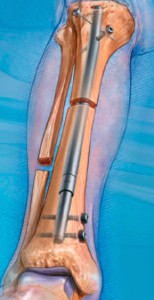Leg Lengthening with intramedullary (internal) nail Stryde – Precice I/II
Limb lengthening, whether in the femur, tibia, or humerus for upper limbs, is performed through small incisions through which the intramedullary nail is inserted. This nail is placed in the leg and, after a proximal tibial osteotomy, is secured with both proximal and distal screws.
After a few days, limb lengthening begins 2-3 times a day, controlling the amount of lengthening using a magnetic motor within the nail, which is externally controlled. Once the programmed lengthening is achieved, the nail stops automatically. The precision of this procedure is extremely high.
This procedure is well-tolerated by patients, but muscle contracture problems can still arise. It’s important to consider the high cost of the nails and the need to remove them once the treatment is completed and consolidation has occurred. In rare cases, approximately 1-2%, a tibial nail can cause painful symptoms in the patellar tendon, according to the experience of many.”
Stryde or Precice II nail

Possible risks of this procedure:
- Wound and bone infection
- Delayed bone consolidation needing a second procedure such as bone grafting
- Deformities needing further surgery
- Metalwork fatigue and break
- Fracture during the surgery.
- Muscles contractures (Achilles Tendon Lengthening might be required in Tibia lengthening)
- Neurovascular problems due to blood vassels or nerve stretching. This complication have never been experienced by our patients but are described in the literature.
Do not hesitate to contact us for further questions
Useful Links



